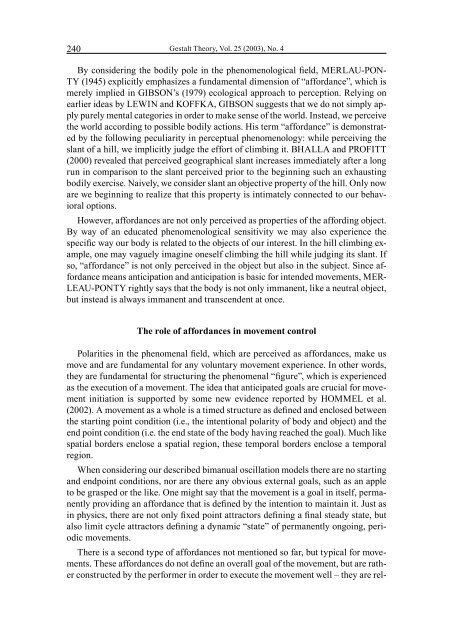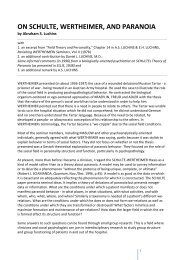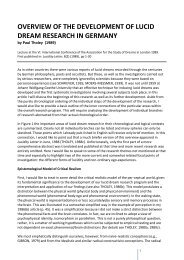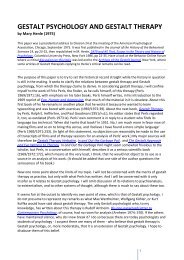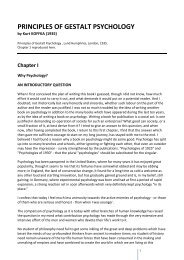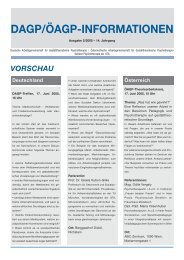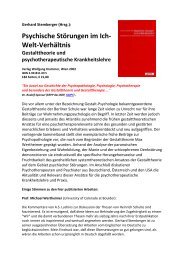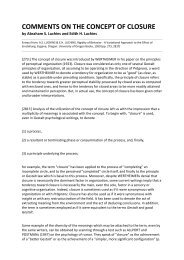Gestalt Factors in Human Movement Coordination - Society for ...
Gestalt Factors in Human Movement Coordination - Society for ...
Gestalt Factors in Human Movement Coordination - Society for ...
You also want an ePaper? Increase the reach of your titles
YUMPU automatically turns print PDFs into web optimized ePapers that Google loves.
240<strong>Gestalt</strong> Theory, Vol. 25 (2003), No. 4By consider<strong>in</strong>g the bodily pole <strong>in</strong> the phenomenological field, MERLAU-PON-TY (1945) explicitly emphasizes a fundamental dimension of “af<strong>for</strong>dance”, which ismerely implied <strong>in</strong> GIBSON’s (1979) ecological approach to perception. Rely<strong>in</strong>g onearlier ideas by LEWIN and KOFFKA, GIBSON suggests that we do not simply applypurely mental categories <strong>in</strong> order to make sense of the world. Instead, we perceivethe world accord<strong>in</strong>g to possible bodily actions. His term “af<strong>for</strong>dance” is demonstratedby the follow<strong>in</strong>g peculiarity <strong>in</strong> perceptual phenomenology: while perceiv<strong>in</strong>g theslant of a hill, we implicitly judge the ef<strong>for</strong>t of climb<strong>in</strong>g it. BHALLA and PROFITT(2000) revealed that perceived geographical slant <strong>in</strong>creases immediately after a longrun <strong>in</strong> comparison to the slant perceived prior to the beg<strong>in</strong>n<strong>in</strong>g such an exhaust<strong>in</strong>gbodily exercise. Naively, we consider slant an objective property of the hill. Only noware we beg<strong>in</strong>n<strong>in</strong>g to realize that this property is <strong>in</strong>timately connected to our behavioraloptions.However, af<strong>for</strong>dances are not only perceived as properties of the af<strong>for</strong>d<strong>in</strong>g object.By way of an educated phenomenological sensitivity we may also experience thespecific way our body is related to the objects of our <strong>in</strong>terest. In the hill climb<strong>in</strong>g example,one may vaguely imag<strong>in</strong>e oneself climb<strong>in</strong>g the hill while judg<strong>in</strong>g its slant. Ifso, “af<strong>for</strong>dance” is not only perceived <strong>in</strong> the object but also <strong>in</strong> the subject. S<strong>in</strong>ce af<strong>for</strong>dancemeans anticipation and anticipation is basic <strong>for</strong> <strong>in</strong>tended movements, MER-LEAU-PONTY rightly says that the body is not only immanent, like a neutral object,but <strong>in</strong>stead is always immanent and transcendent at once.The role of af<strong>for</strong>dances <strong>in</strong> movement controlPolarities <strong>in</strong> the phenomenal field, which are perceived as af<strong>for</strong>dances, make usmove and are fundamental <strong>for</strong> any voluntary movement experience. In other words,they are fundamental <strong>for</strong> structur<strong>in</strong>g the phenomenal “figure”, which is experiencedas the execution of a movement. The idea that anticipated goals are crucial <strong>for</strong> movement<strong>in</strong>itiation is supported by some new evidence reported by HOMMEL et al.(2002). A movement as a whole is a timed structure as def<strong>in</strong>ed and enclosed betweenthe start<strong>in</strong>g po<strong>in</strong>t condition (i.e., the <strong>in</strong>tentional polarity of body and object) and theend po<strong>in</strong>t condition (i.e. the end state of the body hav<strong>in</strong>g reached the goal). Much likespatial borders enclose a spatial region, these temporal borders enclose a temporalregion.When consider<strong>in</strong>g our described bimanual oscillation models there are no start<strong>in</strong>gand endpo<strong>in</strong>t conditions, nor are there any obvious external goals, such as an appleto be grasped or the like. One might say that the movement is a goal <strong>in</strong> itself, permanentlyprovid<strong>in</strong>g an af<strong>for</strong>dance that is def<strong>in</strong>ed by the <strong>in</strong>tention to ma<strong>in</strong>ta<strong>in</strong> it. Just as<strong>in</strong> physics, there are not only fixed po<strong>in</strong>t attractors def<strong>in</strong><strong>in</strong>g a f<strong>in</strong>al steady state, butalso limit cycle attractors def<strong>in</strong><strong>in</strong>g a dynamic “state” of permanently ongo<strong>in</strong>g, periodicmovements.There is a second type of af<strong>for</strong>dances not mentioned so far, but typical <strong>for</strong> movements.These af<strong>for</strong>dances do not def<strong>in</strong>e an overall goal of the movement, but are ratherconstructed by the per<strong>for</strong>mer <strong>in</strong> order to execute the movement well – they are rel-


